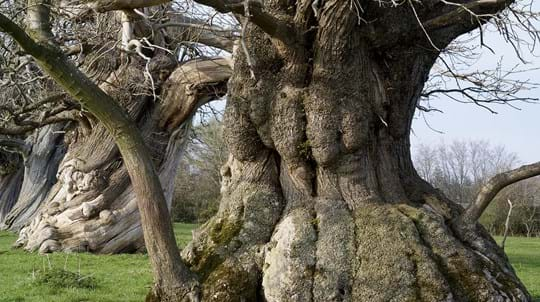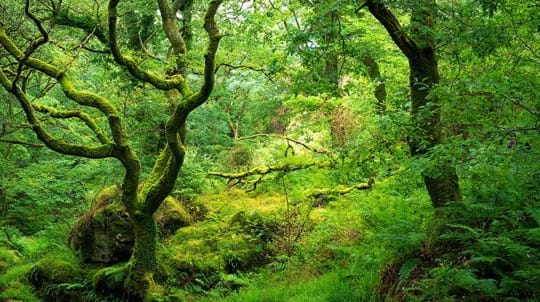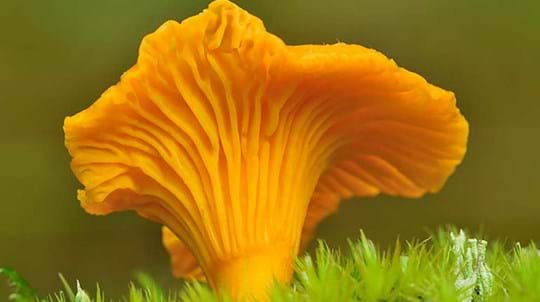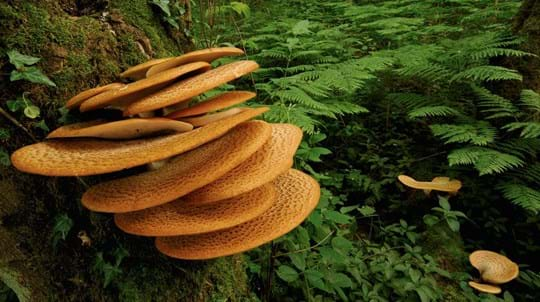
Credit: Alastair Hotchkiss / WTML
The pendulous Usnea ceratina and U. articulata (shown here and known as string of sausages lichen) can be seen in the southwest of the UK.
Dripping off the trees in clean-air woodlands, these bushy beard lichens adorn the branches and trunks and are some of our most conspicuous and beautiful lichens.
Common name(s): beard lichen, old man’s beard, string of sausages lichen
Scientific name: Usnea spp. (including Usnea articulata, U. ceratina, U. cornuta, U. filipendula, U. florida, U. rubicunda, U. subfloridana)
Family: Parmeliaceae
Fruiting season: year-round
Habitat: tree trunks, branches and twigs often high in the canopy
Lichens, or lichenised fungi, are organisms formed by the symbiosis of a fungus species and one or more other organism, usually an alga.
Beard lichens are known as fruticose lichens, which grow like mini shrubs or tassels anchored onto the bark of tree trunks and branches. They are all pale grey-green, and some produce striking disc-like fruit bodies.
Not to be confused with: similar looking lichens growing on trees, including the horsehair lichens, Bryoria and Alectoria species. Like beard lichens, these are intolerant of air pollution and Bryoria horsehair lichens have declined significantly over recent decades. They are less likely to be found than beard lichens across most of the UK, and horsehair lichens tend to be a bit finer, and often more brownish in colour.
Beard lichens once occurred on trees throughout the UK. But the impacts of past sulphur-dioxide pollution and continued nitrogen air pollution from agriculture have resulted in their loss.
Beard lichens can be found throughout the UK and Ireland, especially in areas with clean air.
The most widespread species occurring on twigs and branches is called Usnea subfloridana, and this has been recolonising woods and trees in the London and Midlands areas. But other species are typically found in different parts of the UK.

Credit: Alastair Hotchkiss / WTML
The pendulous Usnea ceratina and U. articulata (shown here and known as string of sausages lichen) can be seen in the southwest of the UK.

Credit: Alastair Hotchkiss / WTML
Usnea filipendula and U. hirta are the beard lichens that grow mostly in the north of the UK

Credit: Alastair Hotchkiss / WTML
The bushy Usnea florida can be found in well-wooded parts of southern and southwest England, Wales and the Welsh Marches, and northern England and Scotland. Look closely at the branches and twigs of trees in old woodlands.
Lichens play an important role in the ecology of woodlands. Lichens on trees provide valuable microhabitats, shelter and food for various small invertebrates.
These in turn are prey for larger insects and birds. They can also be hosts for other species of parasitic fungi. Lichens also provide many other ecosystem services such as carbon cycling and water retention.
Usnea species have been used medicinally for over a thousand years.
Most beard lichens contain usnic acid which is a potent antibacterial and antifungal agent.
It's effective against bacteria including Streptococcus, Staphylococcus and tuberculosis. It was traditionally used to treat wounds; Native Americans used it as a compress to prevent infection and gangrene.
It is also said to be edible and contains a high level of vitamin C.
Like many other lichens, beard lichens have also been used historically for dyes, to create orange, yellow, green, blue and purple textiles. Beard lichens have also been used to make cosmetics, preservatives and deodorants. In some areas, it was used as a fire-starter as it's flammable when dry and crisp.

Trees woods and wildlife
How long do trees live? How old before they're ancient? Get the low-down on ancient trees and where to find them in the UK.

Trees woods and wildlife
Home to myth and legend, where folk tales began. It fuelled our ancestors and still houses thousands of species. Ancient woodland has grown and adapted with native wildlife, yet what remains only covers 2.5% of the UK.

Blog
Kylie Harrison Mellor • 24 Apr 2019

Trees woods and wildlife
A dazzling array of shapes, sizes and colours. Find out about fungi and lichens, from ancient taboos to magic and medicine.

Blog
Amy Lewis • 21 Oct 2021